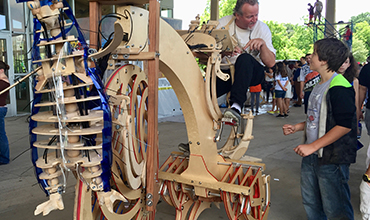When your electronic gadgets break, does your tween fix them? Do you have a child that builds elaborate housing for pets and dolls out of scraps of craft materials and cardboard boxes? Maybe you’re raising entrepreneurial teens with ideas that could make them the next great app creator or “Shark Tank” winner.
If any of this sounds familiar, you may have a maker on your hands. But what exactly does that mean?
What is the Maker Movement?
The Maker Movement is a quickly growing culture that embraces the idea that learning is done best through doing. It includes do-it-yourself individuals and groups that create things, and its members are producers more than consumers, says Irm Diorio, executive director of a makerspace. While some makers work in makerspaces, others tinker in their homes and garages. Some maker interests include robotics, electronics, metalworking, woodworking and traditional arts and crafts.
With affordable access to 3D printers and computers, technology is often a part of the Maker Movement, but it doesn’t have to be.
“Everyone is a maker,” Diorio says, and she encourages others to discover the maker in them. “It’s about finding what really inspires you – gardening, baking, sewing, anything that you would build with your hands. It’s fun and can be functional, but it doesn’t have to be. It’s all about letting your creativity take you for a ride.”
What do makerspaces offer?
Some makers discover their tribe at makerspaces, where adults and children find the community and supplies they need, including equipment and tools that are hard to store at home. Makerspaces often house equipment like 3D printers, laser cutters, wood lathes, saws, welding equipment and sewing machines. These spaces offer community, encouragement and expertise for those working on projects. Makerspaces are also becoming popular in schools because parents, teachers and administrators see the advantages of including hands-on, creative outlets in the learning process.
How can parents support a maker-minded life?
How you help your child flourish at being a DIY kid varies by age. Here are some suggestions that will help guide young makers as they grow.
Preschool:
- Encourage natural curiosities, inclinations or interests.
- Start coding with and without technology. Find lots of ideas at code.org.
- Give them the tools of their trade even if they’re in a junior size. Think miniature toolbox with tools, junior sewing machine or real gardening tools small enough to fit their hands.
- Don’t be afraid to introduce sophisticated vocabulary. Don’t dumb it down.
Elementary:
- Give them a work space and fill it with the best tools that you can afford.
- Volunteer to start a makerspace at your child’s school.
- Create an invention station where your kids can do STEM challenges. For project ideas that can be built with a few common household supplies, try the design spinner at PBS Kids Design Squad Global Build.
- Participate in a science fair.
- Visit your local Maker Faire.
- Have a STEAM closet or basket at home that allows kids to pull out supplies and invent, build or create.
- Provide a coding robot that can be programmed with a tablet.
- Join a LEGO robotics club.
Middle and High School:
- Encourage an apprenticeship in a trade or with a family member or friend who is an expert, such as a computer scientist, car or airplane mechanic, fashion designer or seamstress.
- Attend a certified STEM high school.
- Join a robotics club.
- Give them low-cost technology like Raspberry Pi or Arduino to experiment and create their own technology products.
- Introduce them to a conductive thread so they can make clothes that light up, or show them Makey Makey, an invention kit that can turn items as simple as bananas or staircases into computer touchpads.
Online Resources for the Maker-Minded Family
KiwiCo.com: Delivers art and science projects for kids of all ages for a monthly fee.
Makered.org: Provides support for those interested in integrating maker education into learning environments.
Makerfaire.com: Shares information about Maker Faires all over the world, including Maker Faire Austin.
Makezine.com: Features project ideas, maker news, links to Maker Faires and support for all things maker.
Thingiverse.com: Offers user-created design project files to make with technology such as 3D printers and laser cutters.
Local Resources for Austin DIY Kids
Austin Creative Reuse: Promoting the sustainable practice of reuse, ACR supplies donated crafting supplies of all kinds at reasonable rates for a wide range of creative projects.
Libraries: Check with your local school and public library, many of which offer maker supplies and events. Once reopened, visit Austin Central Library’s makerspace with 3D printers, sewing machines and crafting space.
Summer Camps: Several area camps offer maker-themed day camps that teach skills such as stop motion animation, robotics, baking, STEM activities and film-making. See the Austin Family magazine 2021 Camp Guide for local summer camps that will inspire maker kids.
Janeen Lewis is a freelance journalist, teacher and mom of two. She is a nationally published writer.


















